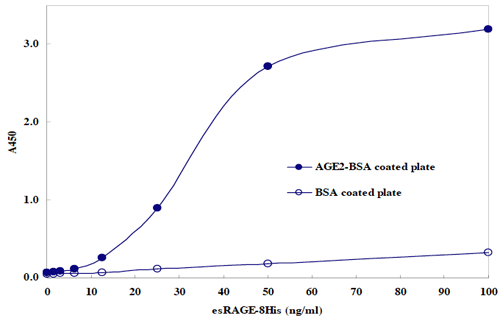CircuLex AGE-RAGE in vitro Binding Assay Kit
| Code | Size | Price |
|---|
| MBL-CY-8151 | 96 Assays | £602.00 |
Quantity:
Prices exclude any Taxes / VAT
Overview
Regulatory Status: RUO
Shipping:
4°C
Storage:
4°C
Images
Documents
Further Information
Background:
Advanced glycation end products (AGEs) are important biochemical compounds found in diabetes
and may be associated with inflammatory processes. In the vessel wall, AGEs are bound to specific
receptors to modulate many cellular properties by activating several signaling pathways. One of these
receptors is called ?Receptor for Advanced Glycation End product? (RAGE).
RAGE is a multi-ligand member of the immunoglobulin superfamily of cell surface molecules that is
expressed in a variety of cell lines, including endothelial cells, smooth muscle cells, mononuclear
phagocytes, pericytes, neurons, cardiac myocytes, mesangial cells and hepatocytes (1, 2). RAGE
interacts with different structures to transmit a signal into the cell and recognizes three-dimensional
structures rather than specific amino acid sequences. Therefore, RAGE seems to fulfill the requirements
of a pattern-recognition receptor. As a member of the immunoglobulin superfamily, it interacts with a
diverse class of ligands, including AGEs (1, 3), HMGB1 (also known as Amphoterin) (4), amyloid
β-peptide (5), amyloid A (6), leukocyte adhesion receptors (7), prions (8), Escherichia coli curli operons
(9), β-sheet fibrils (10) and several members of the S100 protein superfamily including
S100/calgranulins (11). Thus RAGE may have potential involvement in several pathological processes
including inflammation, diabetes, Alzheimer?s disease (AD), systemic amyloidosis and tumor growth
(12).
AGE-RAGE interaction enhances the expression of genes encoding cytokines, growth factors and
adhesion molecules, and increases the classical acute phase proteins. Potential approaches to prevention
and treatment of diabetes and its complications include inhibition of AGE formation, breakage of
preformed AGE-proteins crosslink, blockade of AGE-RAGE interactions with RAGE competitors,
antibody antagonists and RAGE specific metabolic inhibition. Inhibition of AGE-RAGE complex
formation is able to suppress the levels of pro-inflammatory cytokines and growth factors and may be
considered as a target for overcoming diabetic complications.
Description:
The CycLex Research Product CircuLex AGE-RAGE in vitro Binding Assay kit is primarily
designed to screening inhibitors of AGE2 (glyceraldehyde-modified AGE)-sRAGE interaction (soluble
RAGE) in vitro. In addition, this kit can be used for the rapid and sensitive evaluation of inhibitor
candidates as well as characterization of AGE2-sRAGE interaction in vitro. The recombinant sRAGE
used in this assay kit was specially designed by CycLex for keeping the correct conformation to bind
efficiently to AGE2-BSA but not to BSA, which are immobilized on the microplate surface. This
technique allows us measuring the interaction of recombinant sRAGE to AGE2-BSA in a solid-phase
assay system such as a conventional ELISA system.
Gene IDs:
Human: 177 Mouse: 11596
Kit Components:
AGE2-BSA coated Microplate,?BSA coated Microplate,?Recombinant His-tagged sRAGE,?Reaction Buffer,?20X Inhibitor Control Compound,?HRP conjugated anti-His-tag monoclonal antibody,?10X Wash Buffer,?Substrate Reagent,?Stop Solution
Target:
RAGE
References
1. Neeper M, Schmidt AM, Brett J et al.: Cloning and expression of a cell surface receptor for advanced
glycosylation end products of proteins. J Biol Chem 1992, 267: 14998-15004.
2. Brett J, Schmidt AM, Yan SD et al.: Survey of the distribution of a newly characterized receptor for
advanced glycation end products in tissues. Am J Pathol 1993, 143: 1699-1712
3. Schmidt AM, Vianna M, Gerlach M, et al.: Isolation and characterization of two binding proteins for
advanced glycosylation end products from bovine lung which are present on the endothelial cell
surface. J Biol Chem 1992, 267: 14987-14997
4. Hori O, Brett J, Slattery T, Cao R et al.: The receptor for advanced glycation end products (RAGE) is
a cellular binding site for amphoterin. Mediation of neurite outgrowth and coexpression of rage and
amphoterin in the developing nervous system. J Biol Chem 1995, 270: 25752-25761.
5. Yan SD, Zhu H, Fu J, Yan SF, Roher A et al.: Amyloidbeta peptide-receptor for advanced glycation
endproduct interaction elicits neuronal expression of macrophage-colony stimulating factor: a
proinflammatory pathway in Alzheimer disease. Proc Natl Acad Sci U S A 1997, 94: 5296-5301.
6. Yan SD, Zhu H, Zhu A, Golabek A, Du H, Roher A, Yu J, Soto C, Schmidt AM, Stern D, et al.:
Receptor-dependent cell stress and amyloid accumulation in systemic amyloidosis. Nat Med 2000, 6:
643-651.
7. Chavakis T, Bierhaus A, Al-Fakhri N et al.: The pattern recognition receptor (RAGE) is a
counterreceptor for leukocyte integrins: a novel pathway for inflammatory cell recruitment. J Exp
Med 2003, 198: 1507-1515.
8. Sasaki N, Takeuchi M, Chowei H, Kikuchi S et al.: Advanced glycation end products (AGE) and their
receptor (RAGE) in the brain of patients with Creutzfeldt-Jakob disease with prion plaques. Neurosci
Lett 2002, 326: 117-120.
9. Chapman MR, Robinson LS, Pinkner JS et al.: Role of Escherichia coli curli operons in directing
amyloid fiber formation. Science 2002, 295: 851-855
10. Bierhaus A, Humpert PM, Morcos M, et al.: Understanding RAGE, the receptor for advanced
glycation end products. J Mol Med 2005, 83: 876- 886.
11. Hofmann MA, Drury S, Fu C, Qu W et al.: RAGE mediates a novel proinflammatory axis: a central
cell surface receptor for S100/calgranulin polypeptides. Cell 1999, 97: 889-901.
12. Stern DM, Yan SD, Yan SF, and Schmidt AM: Receptor for advanced glycation endproducts (RAGE)
and the complications of diabetes. Ageing Res Rev. 2002, 1: 1-15.



